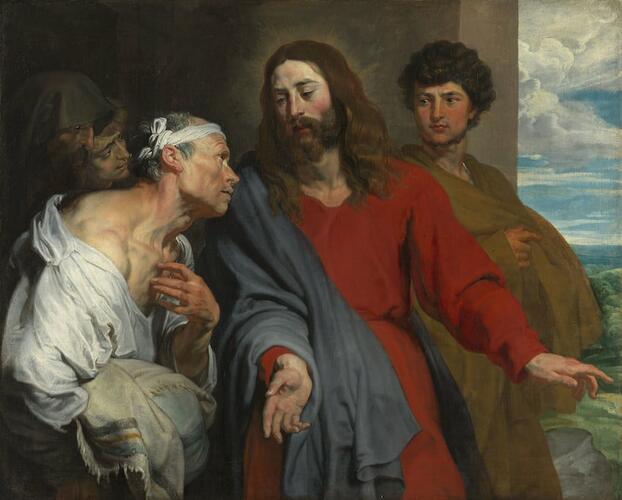Christ Healing the Paralysed Man c. 1619
Oil on canvas | 120.2 x 148.8 cm (support, canvas/panel/stretcher external) | RCIN 405325

Anthony van Dyck (1599-1641)
Christ Healing the Paralysed Man c. 1619
-
This is the work of a supremely brilliant 20-year-old Van Dyck working in Rubens’s studio and very possibly executing a Rubens design, under the supervision of the elder master. This compositional type - an intense, spectator-jostling drama where the canvas area is barely able to contain a small number of half-length figures - was invented by Caravaggio (1571-1610). An excellent example, the Calling of Sts Peter and Andrew of c.1605, is in the Royal Collection. The type was frequently copied by Italian and Netherlandish artists during the first two decades of the seventeenth century. Caravaggio also invented the idea of divine, classically dressed figures rubbing shoulders with the meanest member of the modern street. This encounter has here been rendered more acceptable by basing the paralysed man on an antique statue, then thought to depict the death of Seneca and recorded by Rubens in a series of drawings - one of which (when reversed) provides the precise model for this figure. The man is clearly a wretch: he has the bodily imperfections - rounded back, gnarled muscle forms, prominent veins and mean physiognomy - which contemporaries would have read as the outwards signs of an unfortunate and a sinner. Yet at least his wretchedness is expressed in the language of classical antiquity. He makes an obvious contrast with the nobility of the Apostle to the right, who could be based on one of a variety of classical busts familiar to anyone working in Rubens’s studio.
In this intense drama Van Dyck (or more probably Rubens) expresses the way in which St Matthew’s Gospel (9: 2-8) describes a calling as well as a healing. It immediately precedes the calling of Matthew himself (9: 9). Christ sees the faith of those attending the paralysed man and outrages some Pharisees by first telling him that his sins are forgiven him. This, he says, is more difficult than the simple task of healing, which is then duly accomplished. In this powerful image Christ draws the man up from his knees, and ushers him from out of darkness into the light, in an interaction similar to depictions of the Harrowing of Hell. The Apostle here is most likely to be the recently called St James, the pilgrim saint; all three characters in the drama seem to be setting off on a pilgrimage.
Catalogue entry adapted from Bruegel to Rubens: Masters of Flemish Painting, London, 2007Provenance
Acquired in 1811 by George IV for 3000 guineas from the collection of Pieter de Smeth van Alphen; recorded in the Audience or 'Blue Velvet' Room at Carlton House in 1819 (no 50); hanging in the Picture Gallery at Buckingham Palace in 1841 (no 149)
-
Creator(s)
Acquirer(s)
-
Medium and techniques
Oil on canvas
Measurements
120.2 x 148.8 cm (support, canvas/panel/stretcher external)
152.9 x 181.9 x 10.0 cm (frame, external)
Other number(s)
Alternative title(s)
Christ Healing the Paralytic







